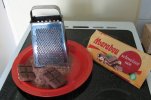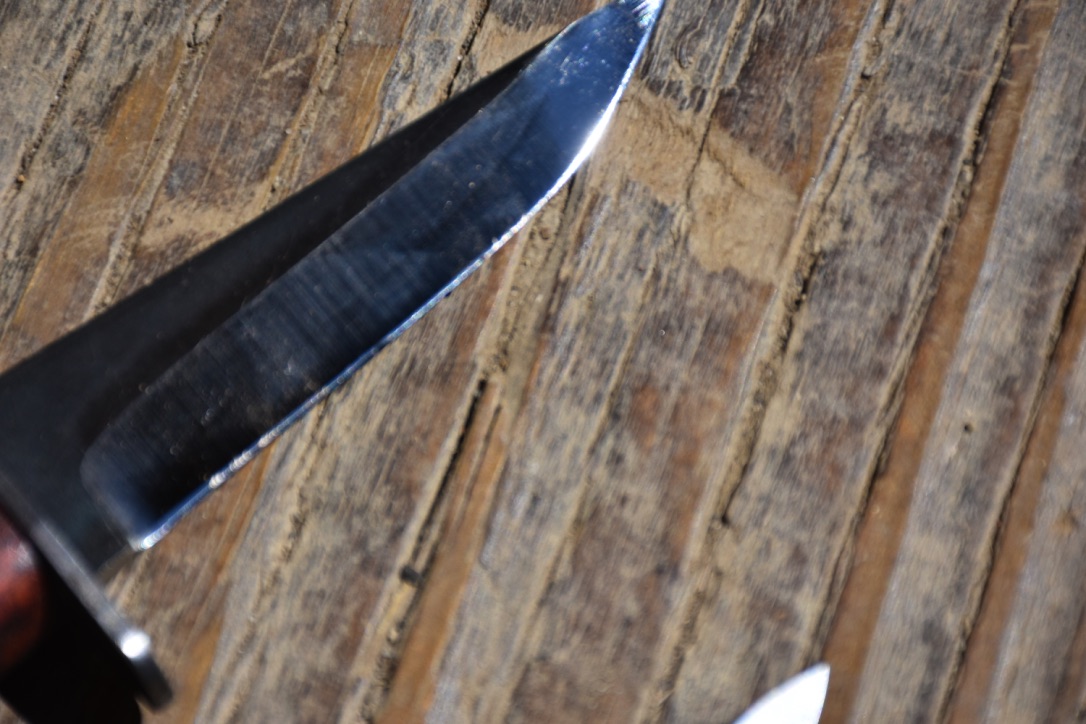- Joined
- Mar 27, 2013
- Messages
- 209
I have not found in my cutting tests that carbide-rich steels are better than carbon steels. The reason is that I have tested extremely sharp blades and in that case there is no room for carbides on the thin cutting edge. In the Figure 1. is shown a microscope image of exceptionally good group of carbides on the cutting edge, generally fewer or nil carbides can be found on very sharp edge.

Fig. 1. Microscope photo of carbides (white) on a cutting edge
It is difficult to photograph the cutting edge because the shallow depth of field of light microscope. For that reason I have made for you a hazelnut chocolate demonstration, which clearly simulates the situation. My test equipments are shown in Figure 2.

Figure 2. Marabou hazelnut chocolate demonstration equipment.
Marabou hazelnut chocolate contains 17% nuts. If we think that chocolate is steel matrix and nuts are carbides, it simulates a carbide-rich steel. The chocolate plate can be sharpened by kitchen grater. So we can visualize the fact that, when a blade is sharpened very sharp, there is no many carbides on the cutting edge (Figure 3). Thus, the steel matrix will make the majority of the cutting work. In addition, the carbides on the thin edge are not surrounded at four sides by steel matrix and they may drop off.

Figure 3. Hazelnut chocolate cutting edge (chocolate is steel and nuts are carbides).
So, the hazelnut chocolate demonstration shows it clearly; when the target is ultimate sharpness, carbide-rich alloy steels are not necessarily better than plain carbon steels.
http://www.juhaperttula.com/

Fig. 1. Microscope photo of carbides (white) on a cutting edge
It is difficult to photograph the cutting edge because the shallow depth of field of light microscope. For that reason I have made for you a hazelnut chocolate demonstration, which clearly simulates the situation. My test equipments are shown in Figure 2.

Figure 2. Marabou hazelnut chocolate demonstration equipment.
Marabou hazelnut chocolate contains 17% nuts. If we think that chocolate is steel matrix and nuts are carbides, it simulates a carbide-rich steel. The chocolate plate can be sharpened by kitchen grater. So we can visualize the fact that, when a blade is sharpened very sharp, there is no many carbides on the cutting edge (Figure 3). Thus, the steel matrix will make the majority of the cutting work. In addition, the carbides on the thin edge are not surrounded at four sides by steel matrix and they may drop off.

Figure 3. Hazelnut chocolate cutting edge (chocolate is steel and nuts are carbides).
So, the hazelnut chocolate demonstration shows it clearly; when the target is ultimate sharpness, carbide-rich alloy steels are not necessarily better than plain carbon steels.
http://www.juhaperttula.com/







![IMG]](/proxy.php?image=http%3A%2F%2F%5BURL%3D%27http%3A%2F%2Fimages41.fotki.com%2Fv1647%2Fphotos%2F4%2F3821034%2F14371630%2FUNADJUSTEDNONRAW_thumb_33d-vi.jpg%255B%27%5Dhttp%3A%2F%2Fimages41.fotki.com%2Fv1647%2Fphotos%2F4%2F3821034%2F14371630%2FUNADJUSTEDNONRAW_thumb_33d-vi.jpg%5B%5B%2FURL%5D%2FIMG%5D&hash=b658a27893343061fbe5f5d0ce9db1db)